Kansas City Packers avenge 1914 loss to Chi-Feds
Article and all photos by Joe Mock, BaseballParks.com
All rights reserved
 |
On April 23, 1914, the Kansas City Packers were defeated by the Chicago Federals (dubbed the “Chi-Feds”), 9-1 in front of an overflow crowd of 21,000. Exactly 100 years later, the Packers avenged that loss with a come-from-behind victory over the bumbling Feds, 7-5.
That gets you up to date on the Federal League scoreboard. Permanently, in fact. That’s because there will never be another Federal League game. It went out of business following the 1915 season.
Then how did the Packers come back to life? That’s because the Arizona Diamondbacks donned replica uniforms and played as KC’s entry in the Federal League in a very special game. It was held at Wrigley Field precisely 100 years to the day after the very first game ever played there. You’ve probably seen “Turn Back The Clock” games before, where teams wear uniforms of clubs from a bygone era. In this one, though, the scoreboard showed that “Kansas City FL” (FL standing for Federal League) was playing the “Chi-Feds,” which was what Chicago’s entry in the League was called before the name Whales stuck. The graphics on the TV broadcast showed that the Packers and Feds were battling. Even the grounds crew wore jackets that said WEEGHMAN PARK on the back.
That’s because Wrigley was called Weeghman Park when the place opened in 1914, having been built by Chicago restaurant magnate Charles Weeghman, owner of the city’s team in the upstart Federal League. And for one day, April 23, 2014, Wrigley Field became Weeghman Park again.
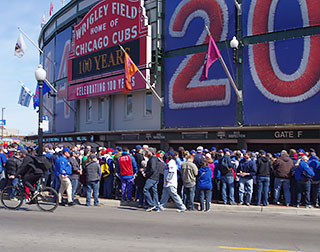 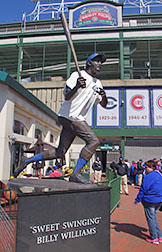 |
More than an hour before gates opened on the morning of April 23, 2014, the number of fans waiting to get into Wrigley (and, consequently, getting to nab both of the promotional give-aways) easily exceeded ten thousand. At every entry gate, fans were lined up for hundreds of feet. At the main entrance behind home plate — where it has existed at the corner of Clark and Addison for 100 years — there was no line. It was just a mob, where the perimeter of the crowd was marked by the travel lanes of the streets (above left).
The fans waiting for the gates to open had lots and lots to look at. The statues of the beloved Cub figures from yesteryear — Ernie Banks, Billy Williams (above right) and Ron Santo — had been clothed in jerseys of the Chi-Feds.
 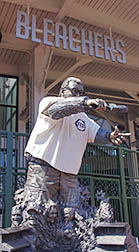  |
Along the exterior walls of the park’s outfield on Sheffield Avenue and Waveland Avenue were multiple murals depicting scenes from decades past. Above left is one that shows images from the short-lived existence of the Chi-Feds. Above right shows scenes and ads from the famous 1932 World Series where folklore has it that Babe Ruth “called” his home run blast into Wrigley’s bleachers in Game 3.
In the center above is the statue of Harry Caray, moved several years ago to the corner of Waveland and Sheffield, in front of the main entrance to the bleachers. Harry, too, is adorned in a Chi-Feds jersey for the occasion.
In addition to the statues and murals, the fans in line had the opportunity to photograph and interact with a group of young adults dressed in attire that would’ve looked very appropriate in 1914. I asked them if they had done this on their own, or whether the Cubs had arranged their appearance. They replied that the team had arranged this, and I think it was a great idea.
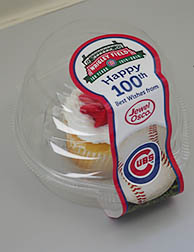  |
The first 10,000 fans through the gates received a birthday cupcake courtesy of Jewel Osco (above left). The first 30,000 fans received a replica of the Chi-Feds jersey that the Cubs were wearing that day, another superbly nice touch. Because it was a very brisk day, most fans added the jersey to the other layers they wore to the park (below left).
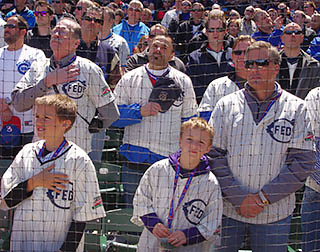 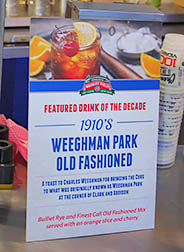 |
There was also a special cocktail for the occasion. At kiosks that served liquor within the ballpark, there was the Weeghman Park Old Fashion (above right). It is a mixture of Bulliet Rye and Finest Call Old Fashioned Mix, served with a cherry and a slice of orange.
  |
What would a trip to Wrigley be without a visit to the most famous seat in the place? In Section 4, row 8 is seat 113 (above left), right next to the wall that separates the fans from the field of play. Of course, on a foul pop-up near this wall, the left-fielder and fans sitting in this area could, on occasion, try for the same ball. Such happened in Game 6 of the 2003 NLCS, when the Cubs were five outs away from their first visit to the World Series since 1945.
They are still waiting. Die-hard Cubs fan Steve Bartman was sitting in seat 113, and he and other attendees reached for the pop-up hit by Luis Castillo, possibly preventing Chicago left-fielder Moises Alou from catching it. The umpires ruled — absolutely correctly — that there was no fan interference on the play, and the game continued. Unfortunately for the North Side faithful, the Cubs then completely unraveled, allowing eight unanswered runs by the Marlins, resulting in an 8-3 defeat. The fans at the game directed their frustration and anger at Bartman, incorrectly blaming him for the loss. When the Marlins easily won Game 7 the next night — thus earning the right to play in the Fall Classic — Cub fans were distraught beyond description, and many made Bartman the goat.
Back to happier subjects — like the cash cow that Wrigley is for the Cubs. The park’s 100th birthday has yielded more souvenirs and apparel than you can imagine. Just a few of the dozens of clothing items are shown above right. Yes, I succumbed to the frenzy and spent way too much on Wrigley apparel.
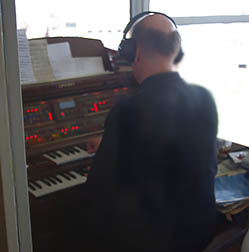 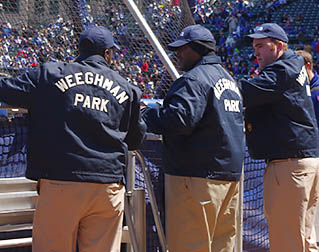 |
The day of the birthday was magical for many reasons — and not just because of the sights. There were also the lovely sounds of an organ filling the air, and I for one feel strongly that music from an organ (like at Dodger Stadium, US Cellular Field and Marlins Park) is what fans at a baseball game should hear, not the poor excuse for music that blares from the PA speakers at virtually every ballpark these days. Well, Gary Pressy is the gifted organist at Wrigley, and his booth is tucked away at one end of the press box (above left). The sounds were particularly appropriate on this day.
After batting and fielding practice, the grounds crew (above right, in their Weeghman Park jackets) moved in to get the field ready for the pre-game ceremony — which was really something special … so keep reading!
The on-field pre-game ceremony was wonderful, especially in the way it wasn’t overdone. There were no boxes on the field shooting fireworks or a rock band screaming at the tops of their lungs. No, this was simple announcements with the music of a marching band. I found it to be very appropriate for the occasion.
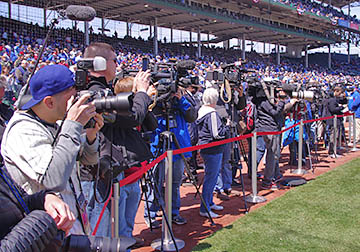  |
Photographers were out in force (above left). I’d gotten there early to camp out a spot, which was a very fortunate thing.
The first person introduced to the crowd was a 100-year-old Illinois resident who brought out the game ball and gave it to the chief of the day’s umpiring crew (above right).
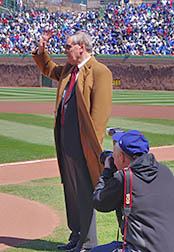  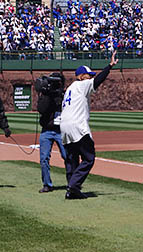 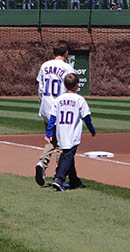 |
The next introductions were of Commissioner Bud Selig (above left) and various people representing the four ownership groups who have controlled the Cubs for the past 100 years. You had descendants of Charles Weeghman, the Wrigley Family, the Chicago Tribune and the current owners, the Ricketts family.
Then came the introductions of athletes who’d had a big impact on sporting events at Wrigley. Since the Bears called Wrigley home for 50 years, Gale Sayers and Dick Butkus (second from the left above) were brought out, with Butkus getting the loudest ovation of anyone introduced during the ceremonies. Past greats of the Cubs were then brought out, including Mr. Cub, Ernie Bank (second from the right above). In a moving tribute to Hall of Famer and former Cubs broadcaster Ron Santo, his grandsons manned third base (above right). Santo died of complications related to cancer in 2010.
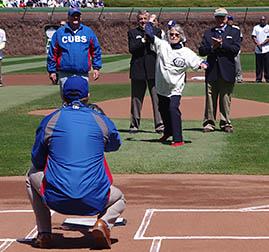 |
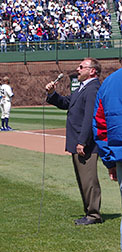 |
The ceremonial first pitch was thrown by Sue Quigg, the grandniece of Charles Weeghman, who paid to construct this ballpark in 1914. Best of all, the ball she threw was from 1914. It had been given to her by her grandmother, who’d used it when making the ceremonial first pitch at the Chi-Feds’ opening day game exactly 100 years earlier.
A rousing version of the National Anthem was sung by Wayne Messmer (above right), which was followed by a fly-over by two biplanes (see photo at the top of the first page of this photo essay).
All in all, a wonderful and tasteful ceremony.
  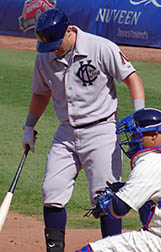 |
Then it was on to the game itself. The Cubs played the role of the Chi-Feds, right down to the jersey and pants they wore. The D-backs played as the KC Packers, and they, too, were attired in replicas of what the Packers wore in 1914. Even the right-field video screen and the hand-operated scoreboard indicated the combatants that day were the Packers and Chi-Feds.
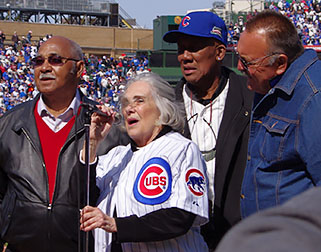 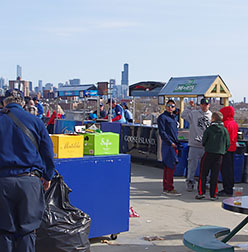 |
To me, the highlight of the day happened in the middle of the 7th inning. At no ballpark is the 7th inning stretch a bigger deal than here, and the Cubs did it right. Since the late Harry Caray turned “Take Me Out To The Ballgame” into an institution, it was only fitting that his widow Dutchie lead the singing of the song. Joining her were Cub greats Billy Williams and Fergie Jenkins and Bear great Dick Butkus. A truly wonderful scene!
Even with the festivities — and a hotly contested game — going on inside the ballpark, there were still a number of fans who preferred to drink and socialize where they could witness none of it. The scene above is from the rooftop bar on the upper level of the ballpark behind home plate. Of course, the view of the Chicago skyline from here is spectacular, and the Cubs’ on-the-field performance often isn’t. In fact, on this day, the home team coughed up a two-run lead in the top of the 9th. The Packers — or Diamondbacks, if you prefer — ended up winning 7-5.
 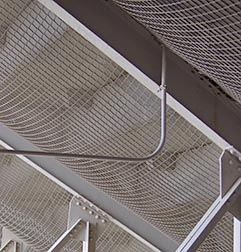 |
At the risk of ending this photo essay of such an uplifting event on a down note, I have to point out that the game was not a sellout. Empty seats could be found down both lines and a few in the upper deck. In my opinion, more than anything, this is a reflection of the Cubs’ very poor showing in the standings the past few years. There were no empty seats in the bleachers, though!
There are also numerous reminders that the upkeep of a 100-year-old ballpark is quite different than for a new one. On the right above, you can see industrial-strength netting hugging the concrete of the stands. That’s to prevent chunks of loose concrete falling onto the fans below.
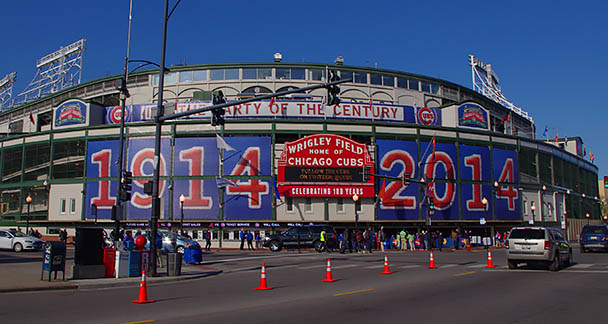 |
I suppose that one way you could look at it is that it’s not only a miracle, but it’s also wonderfully fortunate that this beauty of a ballpark is still around for today’s fans to appreciate. I know I never get tired of going to The Friendly Confines. Here’s to a second century — one with at least one World Series championship in it!